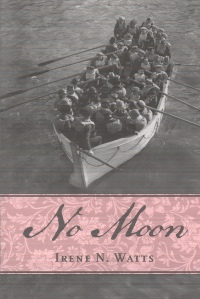| ________________
CM . . .
. Volume XVI Number 36. . . .May 21, 2010
excerpt:
I have to begin this review with the confession that I am not a historical fiction fan. For this reason, I approached No Moon with both some trepidation and a sense of perseverance. Neither was necessary. From the first chapter, this non-historical-fiction reader was engaged in the story of Louisa Gardener, the 14-year-old nursemaid who survives two ocean tragedies. No Moon begins with the story of Louisa and Kathleen going on their first trip to the seaside. Louisa, aged five, and Kathleen, seven, are left in charge of their two-year-old brother. Seduced by the water and the sand, the girls lose track of Johnny, and tragedy quickly follows. Louisa associates the pain and confusion of this day with the ocean and carries that fear throughout her life. At 14, Louisa is struggling with the new roles available to girls in the early 1900s. Her sister, Kathleen, is earning her own money and dreaming of entrepreneurship. Louisa finds herself struggling to find her own identity away from the pressures put on her by her parents and her sister. Louisa finds employment with a wealthy family as a nursemaid and is again controlled by those in authority. Circumstances lead Louisa to be on the Titanic in charge of the family’s small children and in control for the first time in her life. This event forces Louisa to face her fears and act on her own intuition. Her action in some way makes up for her childhood errors. Irene Watts has used both the Titanic and the turn of the century social climate as catalysts for character development and change. Not only Louisa, but also many of the secondary characters, are presented with depth. Nanny Mackintosh, while overbearing and almost cruel to Louisa, is shown to be a product of her upbringing and social class. Nanny’s struggle to exist in a changing society makes her a sympathetic character in spite of her behaviour. Louisa’s parents, her sister, Lord and Lady Milton, the children, and the other servants in the house are well developed. Even Roberts, the “bad” girl, has an air of desperation that adds grey where it could have easily have been written as black and white. Particularly, the women characters are written with strength. Lady Milton, while a woman of privilege and leisure, rises to the occasion of becoming the head of her family and ultimately does the right thing for her children by standing up to Nanny Mackintosh. Louisa’s sister Kathleen, while headstrong, is an independent role model for Louisa who believes she can achieve whatever she sets her mind to. The Titanic sank on a night with no moon. Symmetrically, Louisa’s earlier ocean tragedy also occurred on a night with no moon, giving the title of this novel multiple meanings. This image of darkness before the light is representative of both the death and despair and the growth and hope that are intertwined throughout this novel. The scenes on the Titanic are written from the perspective of Louisa’s “dazzled” perception of the grandeur and majesty of this amazing ship. Through Louisa, we see the decadent details that may have been lost on the first class passengers but were moments of wonder for Louisa and the children. Even in the moments of tragedy, Louisa provides us with enough information to be aware of the sights, the sounds, and the stories that accompanied that historical night. No Moon is a captivating novel that uses the historical setting effectively to enhance the story without overwhelming it. Highly Recommended. Karen Boyd is a graduate student in Language and Literacy at the University of Manitoba and teaches in the Bachelor of Education program.
To comment
on this title or this review, send mail to cm@umanitoba.ca.
Copyright © the Manitoba Library Association. Reproduction for personal
use is permitted only if this copyright notice is maintained. Any
other reproduction is prohibited without permission.
NEXT REVIEW |
TABLE OF CONTENTS FOR THIS ISSUE
- May 21, 2010.
AUTHORS |
TITLES |
MEDIA REVIEWS |
PROFILES |
BACK ISSUES |
SEARCH |
CMARCHIVE |
HOME |
